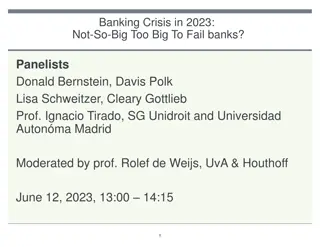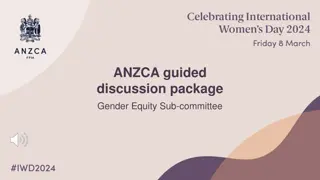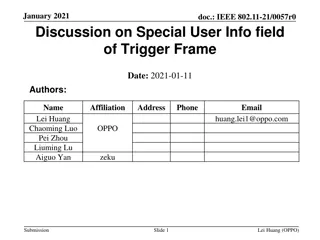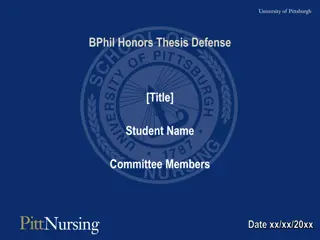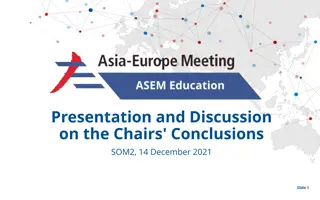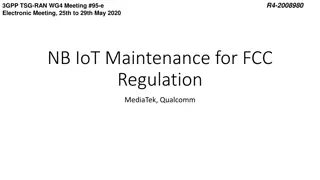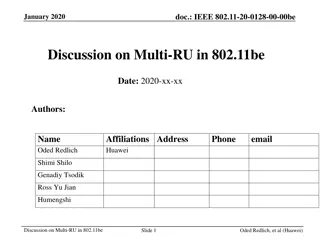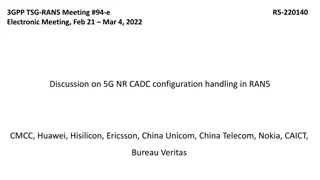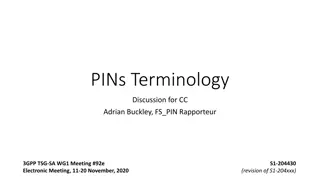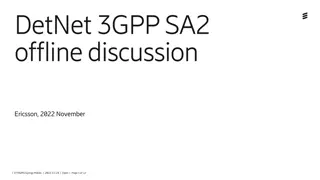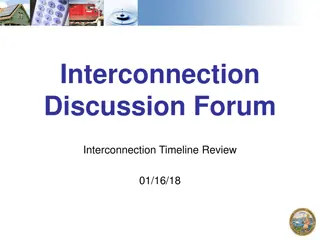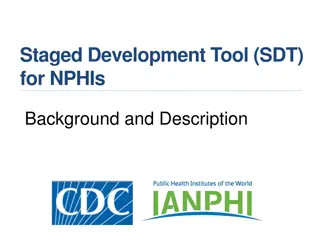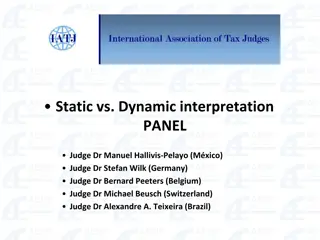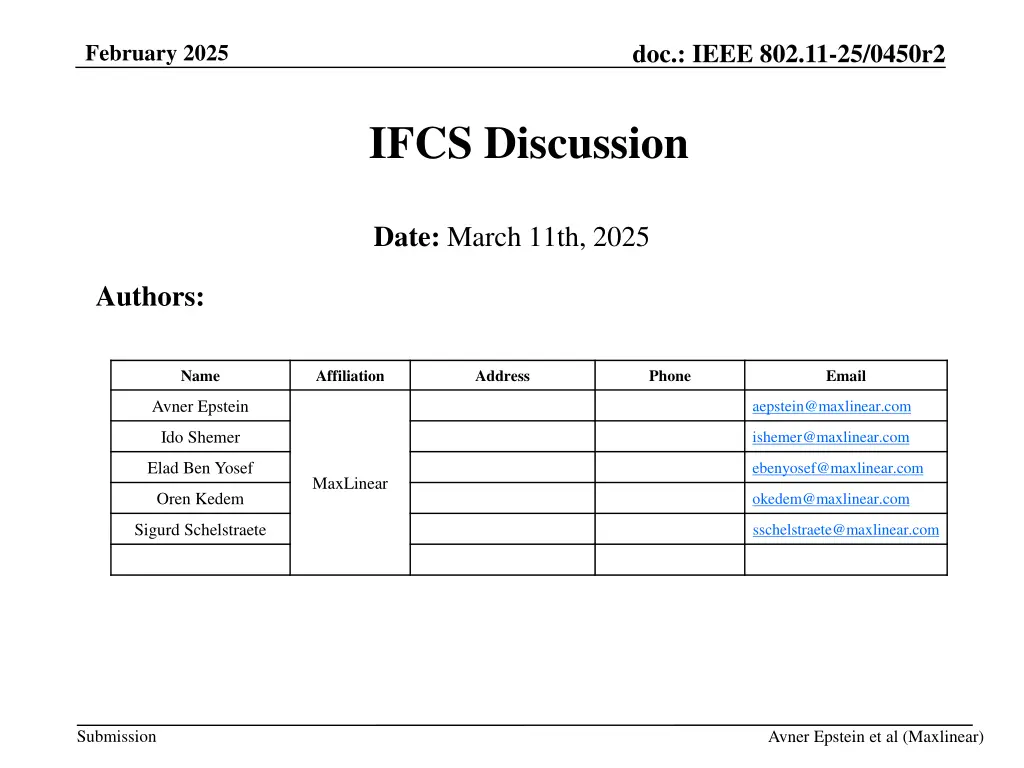
IEEE 802.11-25/0450r2 February 2025 IFCS Discussion
"Exploring the implementation of iFCS in IEEE 802.11-25/0450r2 to validate Trigger Frame for STA switching functionality and the challenges in maintaining compatibility with Non-AP HE STAs. Solutions proposed include increasing iFCS size and handling padding fields in Trigger Frames."
Download Presentation

Please find below an Image/Link to download the presentation.
The content on the website is provided AS IS for your information and personal use only. It may not be sold, licensed, or shared on other websites without obtaining consent from the author. If you encounter any issues during the download, it is possible that the publisher has removed the file from their server.
You are allowed to download the files provided on this website for personal or commercial use, subject to the condition that they are used lawfully. All files are the property of their respective owners.
The content on the website is provided AS IS for your information and personal use only. It may not be sold, licensed, or shared on other websites without obtaining consent from the author.
E N D
Presentation Transcript
doc.: IEEE 802.11-25/0450r2 February 2025 IFCS Discussion Date: March 11th, 2025 Authors: Name Affiliation Address Phone Email Avner Epstein aepstein@maxlinear.com Ido Shemer ishemer@maxlinear.com Elad Ben Yosef ebenyosef@maxlinear.com MaxLinear Oren Kedem okedem@maxlinear.com Sigurd Schelstraete sschelstraete@maxlinear.com Submission Avner Epstein et al (Maxlinear)
doc.: IEEE 802.11-25/0450r2 February 2025 Introduction UHR Trigger Frame Format added iFCS to enable frame validation up to but excluding the padding field. The motivation for iFCS is to enable a STA that uses the Trigger Frame as a trigger for switching functionality (e.g. an EMLSR Non-AP STA that needs to switch to its main radio) to validate the Trigger Frame before the beginning of the padding field; otherwise, the padding field does not fulfil its purpose, or the STA is performing the switch without being able to validate the Trigger Frame. Submission Avner Epstein et al (Maxlinear) Slide 2
doc.: IEEE 802.11-25/0450r2 February 2025 Problem Description In order to maintain backwards compatibility with Non-AP HE STAs it is required to keep the format of user-info and not to exceed the 5 octets allocated for user-info. Therefore, according to SFD, the iFCS field is split into two parts in two consecutive user-info fields: B0 B11 B12 B15 B16 B39 B0 B11 B12 B15 B16 B23 AID12 2011 AID12 2011 1111 IFCS2-0 1111 IFCS3 reserved Size (bits): 12 4 24 12 4 8 Splitting the iFCS into two sub-fields adds non-negligible complexity on the CRC calculation hardware (in both transmit and receive paths). Submission Avner Epstein et al (Maxlinear) Slide 3
doc.: IEEE 802.11-25/0450r2 February 2025 Solution Option A Since the Trigger Frame is intended for UHR STAs, they are able to identify the format of the iFCS field, hence it may be increased to 6 octets, thus allowing the iFCS to be contiguous. Note: the user-info with AID12=2011 (for the iFCS) should be the last user-info before that with AID12=4095 (for the padding). B0 B11 B12 B15 B16 B39 B40 B47 B0 B11 B12 B15 B16 AID12 2011 AID12 4095 1111 IFCS2-0 IFCS3 1111 Size (bits): 12 4 24 8 12 4 >=0 Backwards compatibility: When HE STAs are addressed via Trigger Frame using the HE Variant (first row in the table) there is no backwards compatibility issue. EHT & UHR STAs are not mixed together in the same Trigger Frame, and the EHT STAs are able to identify this is not an EHT Variant based on the Phy Version field in the Special User Info. The only limitation is with the mixed UHR-HE variant (last two rows in the table) in this case an HE STA may be fooled to find its AID in the IFCS3 field; however, mixed UHR-HE variant is currently not part of 11bn SFD (relies on A-PPDU which is currently out-of-scope). Submission Avner Epstein et al (Maxlinear) Slide 4
doc.: IEEE 802.11-25/0450r2 February 2025 Solution Option B According to 11be, the Padding field, if present, is at least two octets in length and is set to all 1s. If the Padding field is present in a Trigger frame, its length is computed as described in 26.5.2.2.3 (Padding for a triggering frame) and 35.5.2.2.3 (Padding for a Trigger frame). The padding field is identified by AID12=4095 as part of the first two octets that are all 1s. The iFCS field could be defined to overlap the padding (after the first two octets); hence only the first two octets shall be all 1s (and not the entire padding field). The risk for backwards compatibility issues is low, since STAs that require padding use this time for processing and/or switching time (e.g. EMLSR) and do not (cannot) verify that the remaining bits in the padding field are all 1s. If an AP calculates the required padding length as N octets it should increase the padding field by 4 octets to account for the iFCS and the total field length should be at least 6 octets (rather than 2, as it is now). B0 B11 B12 B15 B16 B39 B40 B47 B48... AID12 4095 1111 IFCS2-0 IFCS3 Size (bits): 12 4 24 8 >=0 Submission Avner Epstein et al (Maxlinear) Slide 5
doc.: IEEE 802.11-25/0450r2 February 2025 Solution Option C Still use CRC32, but only provide the highest 28bits (omit the lower nibble of the FCS). B0 B11 B12 B15 B16 B39 B0 B11 B12 B15 B16 AID12 2011 AID12 4095 IFCS0_High IFCS3-1 1111 Size (bits): 12 4 24 12 4 >=0 This option has no backwards compatibility issues Since the Trigger Frame is significantly shorter than a QoS data frame, then we argue that 28bits are sufficient, as shown in the next slide. Alternatively, we may use only the highest 3 octets of the FCS (effectively CRC24), while relying on a constant value in the first two octets of the user- info (AID12=2011 and four bits of 1) for increased robustness. Note, the CRC calculation shall remain CRC32, but the lowest 4 bits shall be omitted. Submission Avner Epstein et al (Maxlinear) Slide 6
doc.: IEEE 802.11-25/0450r2 February 2025 Solution Option C (continue) BSRP Trigger Frame: Header = 16 Bytes Common-Info = 8 Bytes Special User-Info = 5 Bytes User-Info = 5 Bytes Total = 16+8+5+N_users*5 Miss detect probability: The probability of a single bit undetected error: Pk= ~2^(-k), where k is the CRC size. The probability of miss-detect of at least 1 bit in an n-bit frame is: 1-(1-Pk)^n N_users Trigger Frame size Miss-Detect Probability with CRC28 QoS data frame size with equivalent miss-detect probability using CRC32 8 552 bit 2.06e-6 1104 Bytes 16 872 bit 3.25e-6 1744 Bytes 32 1512 bit 5.63e-6 3024 Bytes Submission Avner Epstein et al (Maxlinear) Slide 7
doc.: IEEE 802.11-25/0450r2 February 2025 Solution Option D B0 B11 B12 B15 B16 B39 B0 B7 B12 B15 B16 B39 AID12 2011 1111 IFCS2-0 IFCS3 1111 0xFF_FF_FF 1111 4 Size (bits): 12 4 24 8 4 >=0 User-Info N User-Info N+1 Reserved AID range: 0xF00..0xFFF Reserve the AID12 range of: 3840-4094 (255 entries) The IFCS shall be placed in User-info N and N+1 (two User-info fields) In case IFCS3=0xFF (all 1s extremely rare !!!) then User-info N+1 shall be identified as the beginning of padding User-info with AID12=2011 shall always be the one before AID12=4095 (if present). Advantages of this approach: No backwards compatibility issues No CRC reduction Contiguous CRC and byte align Submission Avner Epstein et al (Maxlinear) Slide 8
doc.: IEEE 802.11-25/0450r2 February 2025 Solution Option E B0 B11 B12 B15 B16 B39 B0 B3 B12 B15 B16 B39 AID12 2011 IFCS [31:28] IFCS[3:0] IFCS[27:4] 0xFF 1111 0xFF_FF_FF 8 Size (bits): 12 4 24 4 4 >=0 User-Info N User-Info N+1 Reserved AID range: 0xFF0..0xFFF Reserve the AID12 range of: 4080-4094 (15 entries) The IFCS shall be placed in User-info N and N+1 (two User-info fields) In case IFCS[31:28]=0xF (all 1s) then User-info N+1 shall be identified as the beginning of padding User-info with AID12=2011 shall always be the one before AID12=4095 (if present). Advantages of this approach: No backwards compatibility issues No CRC reduction Contiguous CRC (but not byte align) Only 15 reserved AID12 entries Submission Avner Epstein et al (Maxlinear) Slide 9
doc.: IEEE 802.11-25/0450r2 February 2025 Conclusions The proposed format of iFCS field in UHR Variant of the Trigger Frame adds non- negligible complexity on the CRC calculation hardware (also in receive path). Three solutions have been proposed for working around this problem: Solution A may have backwards compatibility issues with HE STAs; however mixed Trigger Frame is relying on the definition of A-PPDU, which is currently not present neither in 11be nor in 11bn Solution B Low risk for backwards compatibility issues (STAs do not verify that remaining bits in the padding field are all 1s). Solution C no backwards compatibility concern. The simplest solution, relying on the fact that a Trigger Frame is much shorter than data frame and usually transmitted with lower MCS. Solution D neither has any backwards compatibility concerns nor CRC compromising; 255 reserved AID12 entries. Solution E neither has any backwards compatibility concerns nor CRC compromising; only 15 reserved AID12 entries Note, similar considerations might apply also to the MIC field in protected Trigger Frame Submission Avner Epstein et al (Maxlinear) Slide 10
doc.: IEEE 802.11-25/0450r2 February 2025 SP1 Do you agree to change the format of the iFCS field in UHR Variant of the Trigger Frame via Option A? Yes / No / Abstain Submission Avner Epstein et al (Maxlinear) Slide 11
doc.: IEEE 802.11-25/0450r2 February 2025 SP2 Do you agree to change the format of the iFCS field in UHR Variant of the Trigger Frame via Option B? Yes / No / Abstain Submission Avner Epstein et al (Maxlinear) Slide 12
doc.: IEEE 802.11-25/0450r2 February 2025 SP3 Do you agree to change the format of the iFCS field in UHR Variant of the Trigger Frame via Option C? Yes / No / Abstain Submission Avner Epstein et al (Maxlinear) Slide 13
doc.: IEEE 802.11-25/0450r2 February 2025 SP4 Do you agree to change the format of the iFCS field in UHR Variant of the Trigger Frame via Option D? Yes / No / Abstain Submission Avner Epstein et al (Maxlinear) Slide 14
doc.: IEEE 802.11-25/0450r2 February 2025 SP5 Do you agree to change the format of the iFCS field in UHR Variant of the Trigger Frame via Option E? Yes / No / Abstain Submission Avner Epstein et al (Maxlinear) Slide 15
doc.: IEEE 802.11-25/0450r2 February 2025 References Submission Avner Epstein et al (Maxlinear) Slide 16



